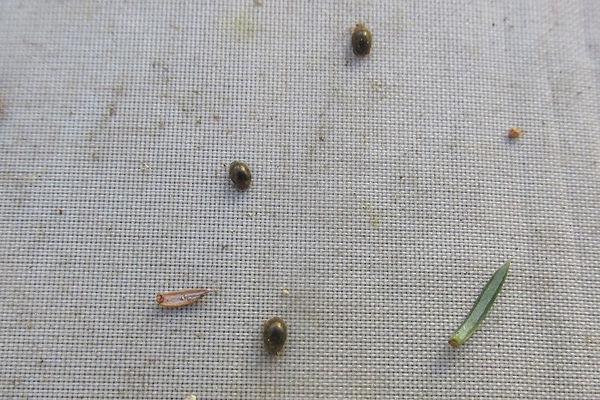Bristly Ladybird Rhyzobius lophanthae
Other names: Red-headed Ladybird Red-headed Rhyzobius
This species is spreading rapidly and is associated with Leyland Cypress but has also spread out in to the wider countryside.
Identification Length 2.0mm
Straightforward if seen well.
Black elytra (wing cases) have distinctive extra long bristles.
The head and pronotum are a brownish red or plum colour, as is the entire underside.
In bright sunshine the head and pronotum can appear bright orange in colour.
On some individuals, and in some dull lighting conditions, the plum colour is darker and at first glance they can resemble one of the all black Scymnus species.

Typical plum-coloured front
Upshire, North Essex

Bright orangey-brown front
Upshire, North Essex

Dark non contrasting front Waltham Abbey, North Essex

Waltham Abbey, North Essex

Waltham Abbey, North Essex

Extra long bristles on sides Waltham Abbey, North Essex

Beaten from Maple Beaulieu Road, New Forest, S Hants

Waltham Abbey, North Essex

Waltham Abbey, North Essex

All orangey brown underside

With Arboreal Ladybird

With Forestier's Ladybird

With 10-spot Ladybird
Upshire, North Essex
Larvae
The larvae can be found whilst searching for adults and are quite distinctive.
They resemble other typical ladybird larvae but are much smaller.
They are a dark grey with a distinctive pale cream patch in the centre, covering four segments.

Upshire, North Essex

Upshire, North Essex

Upshire, North Essex

Upshire, North Essex

Upshire, North Essex

Upshire, North Essex
Habitat
Has a strong affinity with Leyland Cypress. I have often found them in garden wheelie bins which have been filled with prunings from Leyland Cypress hedges.

Leyland Cypress hedge. Waltham Abbey, North Essex

Leyland Cypress prunings containing six Bristly Ladybirds
I have beaten Bristly Ladybird from an Ivy covered fence but I quickly realised that this was located opposite a large Leyland Cypress hedge.

Ivy opposite Leyland Cypress hedge Waltham Abbey, North Essex
They sometimes also occur with Arboreal, Red-flanked and Forestier's Ladybirds in garden wheelie bins containing mixed prunings of evergreen shrubs, although they are rarely common.
I have also beaten Bristly Ladybird from Euonymus shrubs, ornamental Juniper and Yew. They are likely to occur occasionally in other evergreen garden shrubs, although are not as frequent in this habitat as the closely related Forestier's or Epaulet Ladybirds.

Euonymus shrub Upshire, North Essex

Ornamental Juniper Upshire, North Essex

Yew Upshire, North Essex
During 2022 I found this species becoming increasingly common and spreading into other less typical habitats.
I swept one from rough grassland at Canvey Wick, South Essex.
I also started finding them in Ivy alongside Epaulet Ladybirds.

Swept from rough grassland Canvey Wick, South Essex

Ivy covered tree trunk
Fishers Green, Lee Valley, North Essex
In August 2025 I tapped one from an ornamental Acer in Beaulieu Road in the New Forest

Acer tree Beaulieu Road, New Forest, South Hampshire
Additional photographs

Swept from Heather by Mark Hows
Chobham Common, Surrey

Swept from rough grassland
Canvey Wick, South Essex

Broxbourne, Hertfordshire

Broxbourne, Hertfordshire

Nazeing, North Essex

Thundridge, Hertfordshire

Thundridge, Hertfordshire

Nazeing, North Essex

Waltham Abbey, North Essex

Waltham Abbey, North Essex

Waltham Abbey, North Essex

Waltham Abbey, North Essex

Waltham Abbey, North Essex

Waltham Abbey, North Essex

Upshire, North Essex

Upshire, North Essex

Upshire, North Essex

Upshire, North Essex

Upshire, North Essex

Upshire, North Essex

Upshire, North Essex

Upshire, North Essex

Upshire, North Essex

Upshire, North Essex

Upshire, North Essex

Upshire, North Essex

Upshire, North Essex

Upshire, North Essex

Upshire, North Essex

Upshire, North Essex

Upshire, North Essex

Upshire, North Essex

Beaten from Euonymus Upshire, North Essex

Beaten from Juniper Upshire, North Essex

Beaten from Ivy Fishers Green, Lee Valley, North Essex

Beaten from Ivy Fishers Green, Lee Valley, North Essex

Upshire, North Essex

Upshire, North Essex

Upshire, North Essex

Hertford Heath, Hertfordshire

Hertford Heath, Hertfordshire

Beaten from ornamental conifer Upshire, North Essex

Upshire, North Essex
